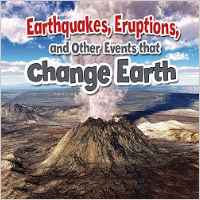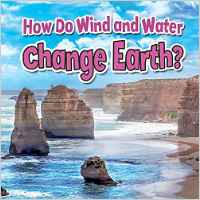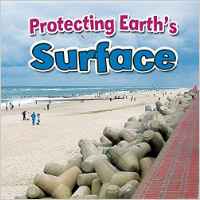| ________________
CM . . .
. Volume XXII Number 41. . . .June 22, 2016

 |
Earth’s Landforms and Bodies of Water. (Earth’s Processes Close-Up).
Natalie Hyde.
St. Catharines, ON: Crabtree, 2016.
24 pp., pbk., hc., pdf & html, $8.95 (pbk.), $22.95 (List RLB), $18.36 (School RLB).
ISBN 978-0-7787-1745-4 (pbk.), ISBN 978-0-7787-1723-2 (RLB), ISBN 978-1-4271-1608-6 (pdf), ISBN 978-1-4271-1604-8 (html).
Subject Headings:
Landforms-Juvenile literature.
Bodies of water-Juvenile literature.
Earth (Planet)-Surface-Juvenile literature.
Physical geography-Juvenile literature.
Grades 2-3 / Ages 7-8.
Review by Gail Hamilton.
*** /4
|
| |
|
 |
Earthquakes, Eruptions, and Other Events That Change Earth. (Earth’s Processes Close-Up).
Natalie Hyde.
St. Catharines, ON: Crabtree, 2016.
24 pp., pbk., hc., pdf & html, $8.95 (pbk.), $22.95 (List RLB), $18.36 (School RLB).
ISBN 978-0-7787-1772-0 (pbk.), ISBN 978-0-7787-1725-6 (RLB), ISBN 978-1-4271-1609-3 (pdf), ISBN 978-1-4271-1605-5 (html).
Subject Headings:
Earthquakes-Juvenile literature.
Volcanoes--Juvenile literature.
Grades 2-3 / Ages 7-8.
Review by Gail Hamilton.
**1/2 /4
|
| |
|
 |
How Do Wind and Water Change Earth. (Earth’s Processes Close-Up).
Natalie Hyde.
St. Catharines, ON: Crabtree, 2016.
24 pp., pbk., hc., pdf & html, $8.95 (pbk.), $22.95 (List RLB), $18.36 (School RLB).
ISBN 978-0-7787-1773-7 (pbk.), ISBN 978-0-7787-1727-0 (RLB), ISBN 978-1-4271-1606-2 (pdf), ISBN 978-1-4271-1621-5 (html).
Subject Headings:
Erosion-Juvenile literature.
Weathering-Juvenile literature.
Grades 2-3 / Ages 7-8.
Review by Gail Hamilton.
*** /4
|
| |
|
 |
Protecting Earth’s Surface. (Earth’s Processes Close-Up).
Natalie Hyde.
St. Catharines, ON: Crabtree, 2016.
24 pp., pbk., hc., pdf & html, $8.95 (pbk.), $22.95 (List RLB), $18.36 (School RLB).
ISBN 978-0-7787-1776-4 (pbk.), ISBN 978-0-7787-1729-4 (RLB), ISBN 978-1-4271-1611-6 (pdf), ISBN 978-1-4271-1607-9 (html).
Subject Headings:
Environmental protection-Juvenile literature.
Environmental engineering-Juvenile literature.
Grades 2-3 / Ages 7-8.
Review by Gail Hamilton.
**1/2 /4
|
| |
|

excerpt:
Scientists are working hard to understand erosion. They meet to share ideas. This is called brainstorming. Brainstorming helps to plan experiments and create new tools. Scientists have learned new ways of measuring soil loss.
Scientists sometimes build models to help them understand a problem. A model is a small copy of something larger. A model of a shoreline is very useful. Scientists can use the model to study how waves erode the coast. They can also test new ways to protect beaches from eroding. (From Protecting Earth’s Surface.)
“Earth’s Processes Close-Up” is a new series which focusses on land and water and the various changes they undergo. The information provided is very basic and well-suited to the target audience, with the text printed in a large, plain font in rather short sentences. Each title features a topic-related experiment or design challenge which can be done with fairly easily obtainable objects. “What Do You Think?” questions, interspersed throughout the books, encourage readers to examine the text more closely and reflect on the concepts, while diagrams, maps and colour photographs not only add to the books’ visual appeal, but also extend readers’ understanding of the text. A table of contents, a glossary and an index are included as well as a brief list of books and age-appropriate websites for further research.
Earth’s Landforms and Bodies of Water discusses the formation of both high and low landforms, from mountains, cliffs, hills and plateaus to valleys, canyons and plains. Readers will also learn about liquid bodies of water (streams, ponds, lakes, rivers and oceans) as well as bodies of water in its frozen form (glaciers). There are instructions for the creation of a three-dimensional model of a region or country. This design challenge will require the assistance of an adult for several reasons: firstly, the reader needs to make some salt dough with the recipe provided (unless the child has coloured modelling clay at home); secondly, the reader needs to search on the internet for photos of physical maps; and finally, the chapter entitled “Models of Earth” does not give adequate information about how map-makers show raised elevations or bodies of water on a map, and so an adult needs to explain how to interpret a physical map.
Earth is a planet of change. Some changes are rapid while others take place over long periods of time. In Earthquakes, Eruptions, and Other Events That Change Earth, readers will learn about natural disasters, such as earthquakes, volcanoes, tsunamis and landslides, as well as how volcanic islands are formed. To better explain to youngsters what causes an earthquake, there is a map of world showing the plates and a diagram of the plates pushing together. But these particular visual aids are not the best examples. It would also have been helpful to include a diagram of how a tsunami is formed. The experiment at the back of the book is rather lame. Readers are instructed to place soil or sand in a shallow pan, dampen the soil and form mountains and hills, and then shake the pan to simulate an earthquake.
How Do Wind and Water Change Earth? highlights weathering and erosion. In this title, readers will learn about the effects of wind and water on rocks and coastlines. Some examples include mushroom-shaped rocks that have been shaped by wind blowing bits of sand and rock against the bottom; flood waters that can move huge rocks great distances; and pounding ocean waves that break rocks down into tiny grains of sand which eventually form beaches. One of the best examples of a river’s effect on rocks is the Colorado River which has been carving out the Grand Canyon for millions of years. It is interesting to note that water moves more earth than any other process. Other topics covered in this title are sandbars, mudslides and glaciers. The activity at the back of the book demonstrates how glaciers affect landforms.
Protecting Earth’s Surface provides a brief review of the other books in the series followed by information about the effects of Earth’s changes on human activities such as farming. But humans can also be to blame for harmful changes. Clearing land for building sites or for farming, for instance, can loosen soil, making it more likely to be eroded by wind or water. This title offers suggestions of what people can do to slow or stop erosion, some examples of which are planting windbreaks, planting trees and shrubs on hills and building levees along rivers. The experiment shows how various materials can slow erosion.
Generally, this is an average series with very basic information for readers who are just beginning to delve into the featured topics.
Recommended with Reservations.
Gail Hamilton is a retired teacher-librarian in Winnipeg, MB.

To comment
on this title or this review, send mail to cm@umanitoba.ca.
Copyright © the Manitoba Library Association. Reproduction for personal
use is permitted only if this copyright notice is maintained. Any
other reproduction is prohibited without permission.
Next Review | Table of Contents For This Issue - June 22, 2016
CM Home | Back Issues
| Search
| CM Archive
| Profiles Archive
|



